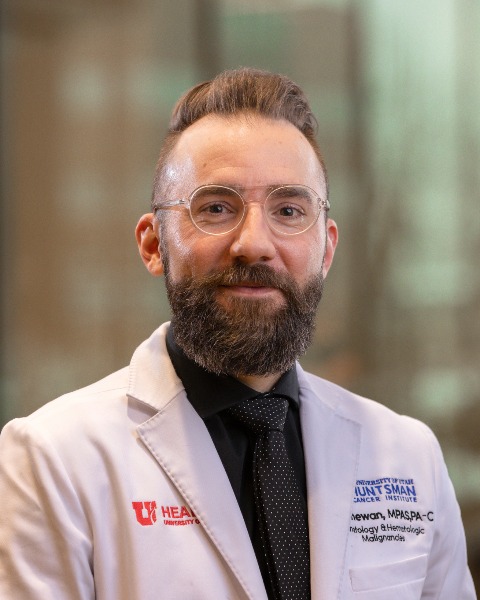Back
Cellular and T cell engager Immunotherapy
Sequencing of Bispecific Antibodies in Relapsed Refractory Multiple Myeloma
P-080: Sequencing of Bispecific Antibodies in Relapsed Refractory Multiple Myeloma
Thursday, September 26, 2024

Samuel Shewan, PA-C (he/him/his)
Advance Practice Provider
Huntsman Cancer Institute
Murray, Utah, United States
Introduction: Therapeutic options for relapsed refractory multiple myeloma (RRMM) are limited, and outcomes remain poor. The introduction of T-cell-directed therapies such as chimeric antigen receptor (CAR) T-cell therapy and bispecific antibodies (BsAb) have led to improved survival in this difficult to treat population. To date, 3 BsAB have been approved for RRMM, two of which – Teclistamab (tec) and elranatamab (elra) target BCMA, while talquetamab (talq) targets the GPRC5D protein. Despite the promising outcomes seen with these agents the optimal sequencing strategy is yet to be defined. Herein, we aim to describe the sequencing trends and associated outcomes in RRMM patients treated with multiple BsAbs at our center.
Methods: IRB-approved, retrospective study of RRMM patients treated at Huntsman Cancer Institute with >1 commercial or investigational BsAb between August 2021 and May 2024. Time-to-event analyses were performed from BsAb initiation, and disease response was assessed using the IMWG criteria.
Results: Sixteen patients received >1 BsAb. Fourteen patients (88%) received 2 BsAb, and 2 patients (13%) received ≥3 BsAb. The most utilized first BsAb was tec (56%), followed by elra (19%), AMG 701 (13%), talq (6%), and cevostamab (cevo) (6%). Similarly, talq was the most utilized second BsAb (81%), followed by tec (13%) and cevo (6%). One patient received three BsAbs (elra-cevo-talq). One patient received four BsAbs (AMG 701-tec-cevo-talq). The overall response rate (ORR) to the first BsAb was 56%. All responders achieved a VGPR or better, and 5 patients (31%) achieved minimal residual disease (MRD) negativity by flow (10-5). ORR to a second BsAb was 38%, 31% of patients achieved a VGPR or better and one patient (6%) achieved MRD negativity. The median PFS seen after the first and second BsAb was 262 days and 119 days, respectively. At data collection five patients remain on second BsAb with average duration of treatment of 232 days. Infectious complications were common; the most common being Rhinovirus/Enterovirus URI (69%), COVID 19 (38%), bacterial pneumonia (31%), UTI (31%) and RSV(25%). Five patients (31%) experienced one or more ≥ Grade 3 infectious complications accounting for 18 instances of hospital admission. Indication for admission included neutropenic fever, bacteremia, and fungal pneumonia.
Conclusions: Treatment of RRMM remains challenging given the limited options and poor outcomes seen in this population. Our results support the sequential use of BsAbs with an ORR of 38% to second BsAb with an average duration of treatment of 232 days for those remaining on their second BsAb at time of analysis. Despite the clinical benefit observed, infectious complications remain a significant risk of this strategy, requiring close and frequent monitoring. A limitation of this analysis is the heterogeneity of treatment between sequenced BsAbs. Further research efforts are needed to determine optimal sequencing of BsAb in this population.
Methods: IRB-approved, retrospective study of RRMM patients treated at Huntsman Cancer Institute with >1 commercial or investigational BsAb between August 2021 and May 2024. Time-to-event analyses were performed from BsAb initiation, and disease response was assessed using the IMWG criteria.
Results: Sixteen patients received >1 BsAb. Fourteen patients (88%) received 2 BsAb, and 2 patients (13%) received ≥3 BsAb. The most utilized first BsAb was tec (56%), followed by elra (19%), AMG 701 (13%), talq (6%), and cevostamab (cevo) (6%). Similarly, talq was the most utilized second BsAb (81%), followed by tec (13%) and cevo (6%). One patient received three BsAbs (elra-cevo-talq). One patient received four BsAbs (AMG 701-tec-cevo-talq). The overall response rate (ORR) to the first BsAb was 56%. All responders achieved a VGPR or better, and 5 patients (31%) achieved minimal residual disease (MRD) negativity by flow (10-5). ORR to a second BsAb was 38%, 31% of patients achieved a VGPR or better and one patient (6%) achieved MRD negativity. The median PFS seen after the first and second BsAb was 262 days and 119 days, respectively. At data collection five patients remain on second BsAb with average duration of treatment of 232 days. Infectious complications were common; the most common being Rhinovirus/Enterovirus URI (69%), COVID 19 (38%), bacterial pneumonia (31%), UTI (31%) and RSV(25%). Five patients (31%) experienced one or more ≥ Grade 3 infectious complications accounting for 18 instances of hospital admission. Indication for admission included neutropenic fever, bacteremia, and fungal pneumonia.
Conclusions: Treatment of RRMM remains challenging given the limited options and poor outcomes seen in this population. Our results support the sequential use of BsAbs with an ORR of 38% to second BsAb with an average duration of treatment of 232 days for those remaining on their second BsAb at time of analysis. Despite the clinical benefit observed, infectious complications remain a significant risk of this strategy, requiring close and frequent monitoring. A limitation of this analysis is the heterogeneity of treatment between sequenced BsAbs. Further research efforts are needed to determine optimal sequencing of BsAb in this population.